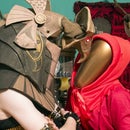Introduction: Busy Book 1
This is my first instructable ever ;)
My husband introduced me to Instructables quite some time ago. He told me that it would be really nice if we both contributed. We are creative souls, but he's more into electronics – something I really admire him for and adore his patience with his projects. I hope he'll share his instructables with you soon!
Anyway, one day he discovered something called a busy book/quiet/sensory book for children, he shared it with me and encouraged to make some from my scraps (you know, lots of boxes filled with felt, ribbons, materials, etc.). The idea was very tempting, but I had no time for it, so I got it in the back of my mind. I also lacked motivation which was always crucial for me to make my DIY brain cells running. And then - BAM! That husband of mine got me pregnant! Still, before making a book for our own child, I made one also for our friends whose baby, Johnny, was just about to be born. So, my first busy book was for him, actually.
We've found many brilliant ideas for book pages in the Internet, also here at Instructables. Sadly, some of those ideas were above my skills. I wanted to keep it as simple as possible and use as much of what I already had at home.
So, here we go:
Tools:
- scissors
- needles (many sizes)
- threads
- embroidery floss
- some random spare buttons
- Velcro strips (from my husband's stuff)
- bubble wrap (we all love it!)
- cellophane sheet scraps
- random swishing materials (I used some plastic sheets from a box of pralines - it produces a perfect swishing sound for my pages)
- cotton wool
- fabric from unused clothes - I strongly recommend velour - it's great for the cover. I also used one polo shirts that my husband never wore – and I had some luck here, since the shirt was of high quality material and it was WHITE!
- a lot of 1 mm wool felt. I had some smaller and bigger scraps left from my previous projects, but I also decided to buy some more here: www.krainafilcu.pl. You’ll find or already have some proper source, too.
I guess that's it.
It's useful to come up with a plan for the pages before you start. I did that myself, even though I modified the ideas later on, which is natural. Anyway, It's easier if you have a plan or at least if you have some core ideas you want to include in the book. Our friends are nature and healthy lifestyle lovers, so I tried to include those features on the pages. I also planned to do about 12 pages, but eventually stopped at 10 – the book was getting a little bit too thick for my plan.
If you have a sewing machine – good for you! Use it whenever possible. This book was done entirely by hands, though. I did not have any sewing machine at that time. Now I do and it really helps me a lot in making a busy book and play mat for my child.
THANK YOU SO MUCH FOR YOUR ATTENTION! Have fun with your Busy Book! :-)
Step 1: PAGE 1 - PARENTS/CAREGIVERS
I strongly recommend including such page for your book's little user. Of course, it depends on a life situation – you can replace parents with only one parent, grandparents, aunts or whoever is taking care of this little creature. I think it makes the book very personal and it gives the caregivers nice boost of energy if he or she is included.
Johnny’s parents are entirely made of felt and I used needles and threads to stitch them to the page. I used back stitch mostly when it comes to the elements on the pages. Not sure what else can I say about this page, I think you get the idea ;-)
Step 2: PAGE 2 & 3: COLORS – Balloons & Flowers
I decided not to stitch balloons to the page permanently. They can be removed from the page and attached back using Velcro bits stitched to the page. Under each Velcro bit, there are little wider bits of felt which indicate where each colorful balloon should be placed (color to color).
At first the balloons were supposed to be flying in the sky, but I decided to tie them to a fence, just to make the page more interesting. The fence and the balloons are filled with cotton wool. The balloons are finished with blanket stitch type. The fence is finished with both back and blanket stitch types.
The flowers are made of felt and buttons. I also decided to add a movable element to this page – a butterfly! Similarly to the balloons – it’s attached to the page via Velcro bit.
Step 3: PAGE 4: SHAPES (and Colors, Too...)
I guess you get the idea from the picture :-) I didn’t want Johnny to lose shapes (no pun intended), so they are attached to the page with thicker thread and hidden in sort of a pocket – this time I did not use any Velcro.
Step 4: PAGE 5: WEATHER
So, we’ve got some sunny and rainy weather here, also day and night. You might add some other elements like snow or a tornado I guess….
Step 5: PAGE 6: NATURE
I’m in love in that little fox you see in the picture. I've found it while browsing through Internet ideas and I plan to include it in my child’s busy book as well. Definitely! I hope you like it, too. The page is all-felt.
Step 6: PAGE 7: BIKE!
Johnny’s parents are huge bike riding lovers. The book would not be complete without it. I hope Johnny will love bike rides as well!! I used felt of course and thread for the spokes and for putting it all together.
Step 7: PAGE 8 & 10: HEALTHY FOOD
Yeah, it was supposed to be page 8 & 9, but I attached the pages all wrong *sigh*. Anyway, hope you like my fruit'n'vegetables ;-) Not much to say here except that adding grapes was really time-consuming....
Step 8: PAGE 9: WINTER TIME + FINISHING TOUCH FOR THE PAGES
Weather strikes back – we've got some serious snowing here!
After finishing each two pages, I sewed them together trying to hide stitches on the left side. Then I filled them all with different types of swishing materials and finished with a blanket stitch. Sometimes I used the blanket stitch all the way through the edges of the pages.
Step 9: TIME FOR THE COVER!
All pages were sewn to a thick scrap of material (I used a long piece of polo shirt collar). As for the cover itself – it’s made of a long piece of a velour material. The back and the front part of the cover were sewn to resemble some sort of a pocket and then filled with some scrap thick paper, to make it a little bit stiffer than the pages. Then, I placed the joined pages at the middle of the cover and sewn to it.

Participated in the
T-Shirt Transformations Challenge













